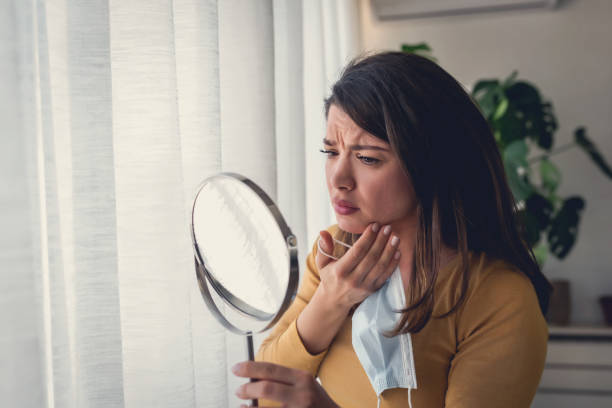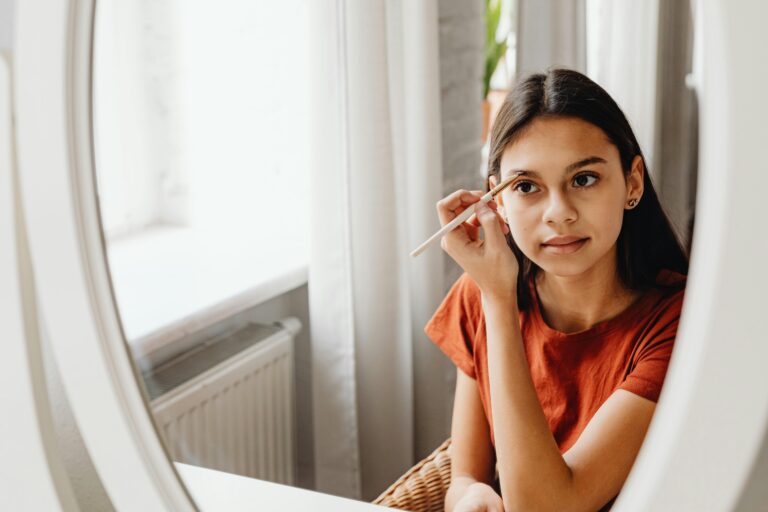The COVID-19 pandemic has brought about significant changes in our daily lives, including the widespread use of face masks. While masks play a crucial role in preventing the spread of the virus, they can also lead to an unfortunate side effect known as “maskne.”
Maskne, a term coined by combining “mask” and “acne,” refers to the skin issues that arise from wearing masks for prolonged periods. These issues include breakouts, irritation, redness, and dryness.
In this article, we will explore effective tips to avoid maskne and maintain healthy skin while wearing masks. We’ll delve into the causes of maskne and provide practical solutions to prevent its occurrence.
What Causes of Maskne?
Friction from the mask
One of the primary causes of maskne is friction between the mask and the skin. When the mask rubs against the skin, it can lead to irritation and break down the skin’s natural protective barrier. This friction can also trap sweat, dirt, and oil, creating a breeding ground for bacteria.
Accumulation of sweat and oil
Wearing a mask for an extended period can cause excessive sweating, especially in hot and humid environments. Sweat, combined with oil produced by the skin, can clog pores and lead to acne breakouts. Additionally, the warm and moist environment under the mask provides an ideal breeding ground for bacteria.
Bacterial growth
Masks can harbor bacteria, particularly if they are not cleaned regularly. When the mask comes into contact with the skin, these bacteria can transfer and cause inflammation, redness, and breakouts. It is essential to maintain proper hygiene practices to minimize bacterial growth and prevent maskne.
Now that we understand the causes of maskne, let’s explore some practical tips to help you avoid this frustrating skin issue.
Tips to Prevent Maskne
Choosing the right mask
- Use breathable fabrics: Opt for masks made from breathable materials such as cotton or bamboo. These fabrics allow for better airflow, reducing moisture buildup and the likelihood of breakouts.
- Opt for a well-fitting mask: Ensure your mask fits snugly but not too tightly. A well-fitting mask reduces friction and prevents excessive rubbing against the skin, minimizing the chances of maskne.
- Consider a mask with a moisture-wicking layer: Some masks come with a moisture-wicking layer that helps absorb sweat and keeps the skin dry. These masks are particularly useful during intense physical activities or in humid environments.
Practice good hygiene
- Cleanse your face before and after mask-wearing: Gently cleanse your face with a mild cleanser before putting on a mask. This helps remove excess oil, dirt, and bacteria from the skin. Similarly, cleanse your face after removing the mask to maintain a clean and healthy complexion.
- Avoid harsh cleansers or excessive washing: While it’s important to keep your skin clean, avoid using harsh cleansers or washing your face excessively. These can strip the skin of its natural oils, leading to dryness and potential irritation.
- Use non-comedogenic and fragrance-free products: Choose skincare products that are non-comedogenic and free of fragrances. Non-comedogenic products are less likely to clog pores, while fragrance-free products reduce the risk of skin irritation and sensitivity.
Moisturize and protect your skin
- Apply a lightweight moisturizer: After cleansing your face, apply a lightweight, oil-free moisturizer. This helps keep the skin hydrated and creates a protective barrier between the mask and your skin.
- Use a barrier cream or ointment: Consider using a thin layer of barrier cream or ointment on areas prone to friction or irritation. This extra protection reduces the chances of maskne and soothes the skin.
- Apply sunscreen on exposed areas: If you’re wearing a mask that doesn’t cover your entire face, remember to apply broad-spectrum sunscreen with an SPF of 30 or higher on the exposed areas. Sunscreen protects the skin from harmful UV rays, preventing sun damage and potential breakouts.
Minimize makeup
- Opt for minimal or no makeup under the mask: Whenever possible, go makeup-free under your mask. If you prefer wearing makeup, keep it minimal, focusing on the eyes and avoiding heavy foundation or products that may clog pores.
- Use non-comedogenic and oil-free products: Choose makeup products labeled as non-comedogenic and oil-free to minimize the risk of clogged pores and breakouts. Look for water-based formulas that allow your skin to breathe.
- Remove makeup thoroughly at the end of the day: Make it a habit to remove your makeup completely before bed. Use a gentle makeup remover or cleanser to ensure your pores are free from any residue that can contribute to maskne.
Take mask breaks
- Whenever possible, remove your mask safely: If you find yourself in a safe and socially distanced environment, take short breaks from wearing your mask. This allows your skin to breathe and reduces the prolonged contact that can contribute to maskne.
- Allow your skin to breathe: During mask breaks, let your skin breathe freely. Avoid applying any products immediately after removing the mask, giving your skin a chance to recover and rejuvenate.
- Avoid touching or adjusting your mask frequently: Touching your mask frequently transfers bacteria and oils from your hands to your face, increasing the risk of maskne. Try to avoid touching or adjusting your mask unnecessarily.
Launder your masks regularly
- Wash cloth masks after each use: If you’re using reusable cloth masks, it’s crucial to wash them after every use. Use hot water and a fragrance-free, gentle detergent to remove dirt, bacteria, and oils effectively.
- Use a fragrance-free and gentle detergent: Avoid using harsh detergents or fabric softeners that may irritate the skin. Opt for fragrance-free and hypoallergenic options to minimize the risk of skin reactions.
- Dry masks completely before reuse: Ensure your masks are completely dry before using them again. Damp masks can breed bacteria, exacerbating maskne issues. Hang them in direct sunlight or use a dryer to expedite the drying process.
Addressing Maskne Flare-ups
A. Use spot treatments
- Look for ingredients like benzoyl peroxide or salicylic acid: When maskne flare-ups occur, spot treatments containing benzoyl peroxide or salicylic acid can be beneficial. These ingredients help to unclog pores and reduce inflammation.
- Apply targeted treatments on affected areas: Using a cotton swab or clean fingertips, apply a small amount of spot treatment directly on the affected areas. Avoid applying it to unaffected areas to prevent unnecessary dryness or irritation.
- Avoid overusing or harshly scrubbing the skin: While spot treatments can be helpful, it’s important not to overuse them. Excessive application or harsh scrubbing can lead to dryness, peeling, and further skin irritation. Follow the instructions provided with the product and use them sparingly.
B. Seek professional advice
- Consult a dermatologist for severe or persistent maskne: If you’re experiencing severe or persistent maskne despite following preventive measures, it’s advisable to consult a dermatologist. They can provide personalized guidance and recommend suitable treatments for your specific skin concerns.
- Explore prescription or topical treatments: Dermatologists may prescribe topical treatments or recommend over-the-counter products specifically formulated to treat acne or mask-related skin issues. Follow their advice and treatment plan diligently for best results.
C. Maintain a healthy lifestyle
- Follow a balanced diet: Eating a well-balanced diet rich in fruits, vegetables, whole grains, and lean proteins can support overall skin health. Avoid excessive consumption of sugary or greasy foods, as they can potentially worsen skin conditions.
- Stay hydrated: Drink an adequate amount of water daily to keep your skin hydrated and flush out toxins. Proper hydration supports the skin’s natural functions and helps maintain a healthy complexion.
- Manage stress levels: Stress can contribute to various skin issues, including acne. Practice stress management techniques such as exercise, meditation, or engaging in hobbies to reduce stress levels and promote overall well-being.
Conclusion
Preventing maskne requires a proactive approach and consistent adherence to good skincare practices. By choosing the right mask, practicing good hygiene, moisturizing and protecting the skin, minimizing makeup, taking mask breaks, and laundering masks regularly, you can significantly reduce the occurrence of mask-related skin issues. Additionally, addressing maskne flare-ups with spot treatments and seeking professional advice when needed will help you maintain a clear and healthy complexion.
FAQs
1. How long should I wear the same mask before washing it?
It is recommended to wash cloth masks after each use. By washing them regularly, you remove dirt, bacteria, and oils that may have accumulated on the mask, reducing the risk of maskne.
2. Can I use any type of moisturizer under my mask?
It is best to use lightweight, oil-free moisturizers under your mask. These moisturizers provide hydration without clogging the pores or adding excess oil, reducing the chances of maskne.
3. Are there any specific ingredients I should look for in my skincare products to prevent maskne?
Look for non-comedogenic products, which are formulated to not clog pores. Additionally, ingredients such as hyaluronic acid, niacinamide, and tea tree oil can be beneficial for acne-prone skin.
4. How can I clean my mask if I don’t have access to a washing machine?
If you don’t have access to a washing machine, you can hand wash your mask using hot water and a fragrance-free, gentle detergent. Scrub it thoroughly, rinse well, and let it air dry completely before reuse.
5. Is it necessary to wear sunscreen under a mask?
If your mask doesn’t cover your entire face, it is essential to apply sunscreen on the exposed areas. UV rays can penetrate through the mask, and unprotected skin may be at risk of sun damage and increased sensitivity.



